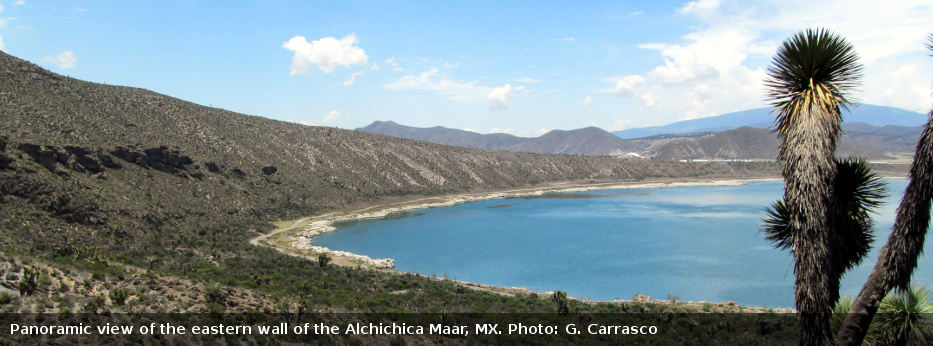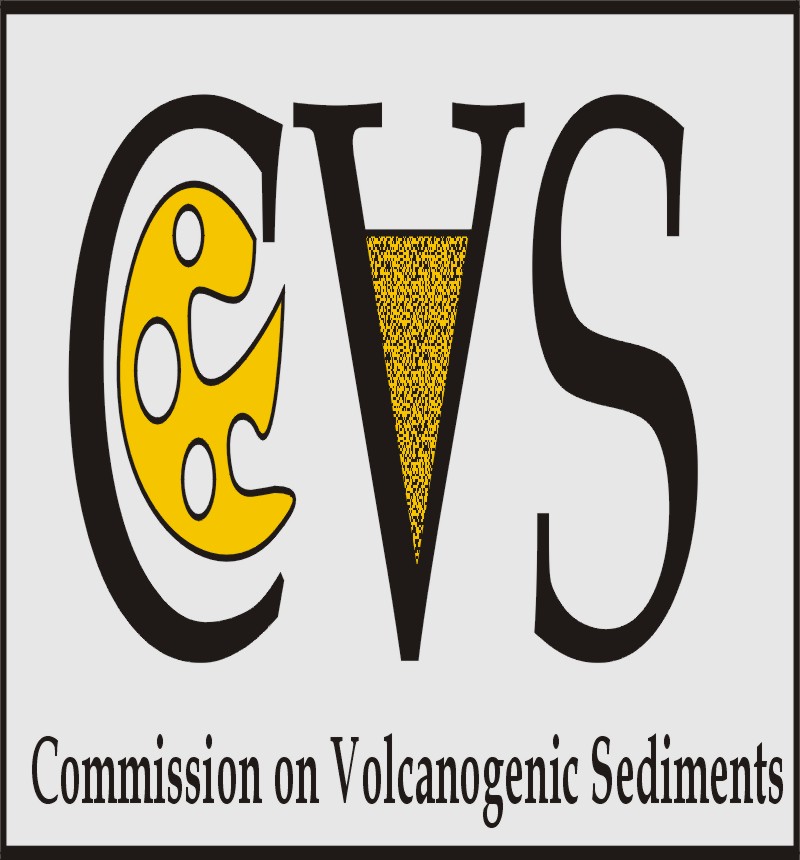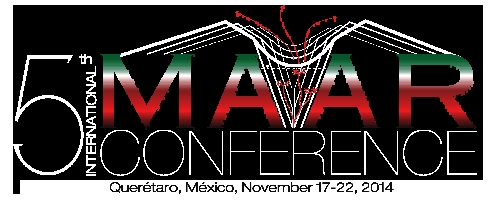
The CVS is proud to sponsor the 5th International Maar Conference, in November 17-22, 2014. Querétaro, Mexico.
Scope Mexico’s geodiversity makes it a unique natural laboratory where volcanism of different ages and styles is widely exposed along the country. In addition to the large stratovolcanoes that characterize the landscape of the central part of Mexico, large monogenetic volcanic fields, mainly formed by clusters of scoria cones, maars, lava domes, and extensive lava fields are common in the Trans Mexican Volcanic Belt (TMVB), an active subduction-related arc. TMVB monogenetic fields are dominated by basaltic andesites, but some, such as the Serdán Oriental and Valle de Santiago fields, display a broad spectrum in lava compositions from mafic alkalic to rhyolitic. The most famous example of a monogenetic eruption in Mexico is that of the Paricutin volcano, which erupted from 1943 to 1952, forming part of perhaps the largest dominantly monogenetic field worldwide, the Michoacán-Guanajuato volcanic field.
North of the TMVB, mantle and lower crustal xenolith-bearing mafic alkalic rocks are associated with scattered maar- and scoria cone-forming vents within a broad region that is considered the southern extension of the Basin and Range Province.
Following the trend established in the previous meeting in New Zealand, the 5th International Maar Conference will focus on both maars and other types of monogenetic volcanoes. We have proposed sessions related to the architecture and evolution of these types of volcanoes, as well as in environmental studies, crater lakes, structural and tectonic settings, hazards, economic and cultural aspects, analog experiments and modeling.
Several field trips will be scheduled during this meeting, which will allow the participants to explore a diversity of volcanic landforms but with a focus on maars. All trips will visit sites that have particular features controlling the formation of maars, allowing discussion on topics including, but not limited to, fractured vs. granular aquifer conditions, migration of locus of explosions, magma composition, dry-to-wet and wet-to-dry evolutionary trends, structural setting, role of eruption rate. Examples of well-documented maars and other monogenetic volcanoes will be explored in detail due to the well-preserved exposures in the selected sites.
Some important dates related to the 5IMC Conference: November 17-22, 2014 Pre-conference field trip: November 15-17, 2014 Intra-conference field trip: November 20, 2014
Post-conference field trip: November 23-35, 2013 Abstract submission deadline: June 15, 2014
Venue CAC Auditorium, Campus Juriquilla, UNAM, Querétaro, México
Location and Access Querétaro is conveniently located in the geographic center of México. It is only 210 km north of Mexico City and it is the first stop for many travelers on the country’s circuit of colonial-era cities.
How to get Queretaro: By plane- Querétaro International Airport (AIQ) is 34 km east of Querétaro city, offering convenient international connections to Houston & Dallas, Texas (USA) By bus- Regular bus service connections are scheduled hourly between terminals 1 and 2 of Mexico City’s International Airport and Querétaro bus terminal, with the trip taking about three hours. By car- Driving from Mexico City takes about 2.5 hours by federal Highway 57.
Information about Querétaro Queretaro is a modern industrial city built around a beautiful colonial center. It is one of the safest and cleanest cities of the country, with a wide range of tourist attractions including historic haciendas converted into luxurious hotels. The city was the third most important city during Mexico’s colonial era, when Spain governed the land. Today it is a favorite spot for rest and relaxation. The colonial city of San Miguel de Allende, the magnificent Peña de Bernal (claimed to be one of the largest worldwide monoliths), Tequisquiapan hot springs and the Ezequiel Montes vineyards are within 45 minutes drive from Querétaro. Some of these localities are considered “Magic Villages”, towns that have been selected by Mexico’s Ministry of Tourism as localities that “hold a very special cultural, historical or social importance” within the country (http://www.explorandomexico.com/about-mexico/4/217/)
Querétaro’s historic downtown was declared a World Heritage Site by the United Nations Educational, Scientific and Cultural Organization (UNESCO) for its rich history and unmatchable collection of baroque-style mansions, houses and churches. Mexico’s independence from Spain began right in the heart of Querétaro’s downtown, where conspirators held clandestine meetings to plan their rebellion.
Organizing Committee Chairs Gerardo Carrasco-Núñez Jorge Aranda-Gómez
Members Pablo Dávila- academic support Mario López- academic support Michael Ort- academic advisor Karoly Nemeth- organizing advisor
International Advisory Committee Michael Ort Bernd Zimanowski Karoly Nemeth Ian Smith James White Greg Valentine Volker Lorenz Pierre-Simon Ross Guido Giordano
Local support Jesús Silva- Technical Editor Juan Manuel López- Technical support Ulises Alvarez-webmaster Emilio Nava- Technical support
Proposed sessions 1. Architecture and Evolution of Maars. Geology, Petrology, Geophysics 2. Environmental Studies in Maars and other Crater-lakes – Biology, Limnology, Paleoclimate, Lake sedimentation 3. Monogenetic Volcanic Fields. Structural and Tectonic Settings, Causes of magmatic and phreatomagmatic activity 4. Maar-related Hazards (volcanic, hydrogeologic, subsidence, etc.) 5. Economic and Cultural Aspects associated to Monogenetic Volcanism. Mineral Resources, Quarries, Tourism, Land Management 6. Experiments and Modeling of Water-Magma Interactions and Other Physical Processes
Proposed Field trips Pre-conference: 1. November 13-17- 5 days (4 nights) Monogenetic volcanism of the Michoacán-Guanajuato Volcanic Field: Phreatomagmatic craters of the Zacapu basin and scoria cones of the Paricutin region. Field trip leaders: Claus Siebe, Marie Noelle Guilbaud, Saúl Salinas, and Lourdes Godinez (Instituto de Geofísica, UNAM)
2. November 15-17 – 3 days (2 nights) Maars associated to fracture and/or conduit controlled aquifers in folded limestones in San Luis Potosí. Field trip leaders: José Jorge Aranda-Gómez, Pablo Dávila-Harris, and Gerardo Carrasco-Núñez (Centro de Geociencias, UNAM & IPICYT)
Intra-conference (included in registration) November 20, 2014. The Valle de Santiago maars: stratigraphy in rhyolitic tuff-ring and active post-desiccation subsidence at the bottom of a maar lake. Field trip leaders: José Jorge Aranda-Gómez & Gerardo Carrasco-Núñez (Centro de Geociencias, UNAM) Post-conference: November 23-25– 3 days (2 nights). Contrasting evolution of Maar volcanoes, cinder cones and and lava domes in the Serdán-Oriental basin, Eastern Mexican Volcanic Belt. Field trip leaders: Gerardo Carrasco-Núñez, Michael Ort, Lee Siebert (Centro de Geociencias, UNAM & Northern Arizona University) et al.
Expression of Interest Please send an email directly with the completed form as an attachment to maar2014@geociencias.unam.mx by 30th November 2013 (http://maar2014.geociencias.unam.mx/sites/default/files/5IMC_2_Expression%20of%20interest_Final.doc)
Sponsors Commissions on Monogenetic Volcanism, Volcanogenic Sediments and Volcanic Lakes
Contact and further information: maar2014@geociencias.unam.mx WEBPAGE: http://maar2014.geociencias.unam.mx
Gerardo Carrasco Núñez Director Centro de Geociencias, Campus UNAM Juriquilla Boulevard Juriquilla 3001 Querétaro, Qro., 76230 Tel. 442 238 11 04/ 196 Red UNAM 34104/196 direccion@geociencias.unam.mx

